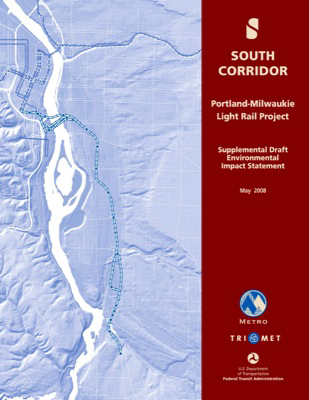No Light Rail in Vancouver!
Another Portland Light-

Comments on the draft environmental impact statement for the Milwaukie light-

Although it is doubtful that Metro cares what the Antiplanner thinks, here is what I will tell them, though possibly in more polite language.
While this may not be the most pathetic light-
This is predicted to reduce driving by 0.1 percent. Peak-
This huge decrease in auto driving is expected to reduce energy consumption by, at
most, 0.1 percent (table 3.12-
Planners also presumed that automobiles will not get any more energy efficient than
they are today (page 3-
Planners also predict that operating the line will reduce CO2 emissions by 0.1 percent.
Since most Oregon electricity comes from hydroelectric dams, you would think that
CO2 emissions would be reduced by more than the energy savings. But, of course, they
are going to keep running a lot of buses that will feed into the light-
The DEIS fails to estimate the CO2 emissions during construction. I suspect that
hydroelectricity is not going to be a big factor in the energy cost of construction.
Instead, it will mainly be fossil fuels — the fuels needed to make steel, the fuels
needed to transport and install all the materials. Burning fossil fuels generates
about 150 to 200 pounds of CO2 per million BTUs of energy. Using the lower number
suggests that construction will produce enough CO2 that it will take 19 years of
operational savings to make up for it. And this doesn’t even count the huge, non-
Need I say again that they didn’t take into account future improvements in auto energy efficiencies, which in turn will reduce future auto CO2 emissions? As with energy, this means this project is a net greenhouse gas producer.
So the light-
Portland expects to pay somewhere between $1.0 and $1.4 billion, depending partly
on whether you are talking about 2007 dollars or “year of expenditure” dollars (table
5.1-
Ironically, this bridge will be just downstream from the Sellwood Bridge, which desperately needs to be replaced at a cost of about $100 million — but strangely, no one seems to be able to find the money for that.
Unfortunately, Portland always seems to be able to find money to build light rail.
They tapped the federal government for 74 percent of the cost of the Interstate (yellow)
line that they hope to eventually extend into Vancouver, Washington (about which
more next week). Another 8 percent of the cost of that line came from tax-
For the Milwaukie line, they plan to use $338 million in state lottery money. That money was originally intended to go for schools, but who needs schools when you have light rail? They hope to get the rest from the feds and various local sources. For example, they’ve asked the city of Milwaukie to pony up $5 million.
So there you have it: trivial benefits, huge costs. The fact that the region could
improve bus service and get as many benefits for a tiny fraction of the cost is unimportant
to Portland decisionmakers, who see light rail as their signature symbol, want to
use it to impose higher densities on neighborhoods along the way, and no doubt are
aware that light-
Trackback • Posted in Transportation
Reprinted from The Antiplanner